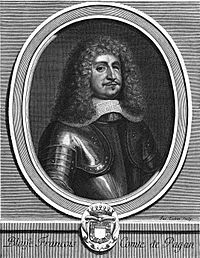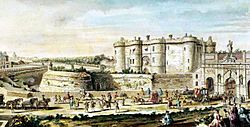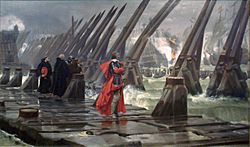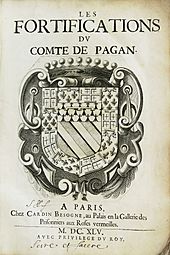Blaise Francois Pagan facts for kids
Quick facts for kids
Blaise François Pagan
|
|
|---|---|

Blaise François Pagan
|
|
| Born | 3 March 1604 Saint-Pierre-de-Vassols, Vaucluse |
| Died | 18 November 1665 (aged 61) Bastille Paris |
| Buried |
Church of Saint Antoine-des-Champs
|
| Allegiance | |
| Service/ |
Soldier and Engineer |
| Years of service | 1616-1642 |
| Rank | Maréchal de camp 1642 |
| Battles/wars | Huguenot rebellions 1620-1629 Montauban 1622 La Rochelle 1628-1629 Mantuan Succession 1628-1631 Franco-Spanish War 1635-1659 Saint-Omer 1638 Arras 1640 Bapaume 1641 |
Blaise François Pagan (1603–1665) was a French soldier and a brilliant military engineer. He served in the army of Louis XIII, a king of France. His military career ended in 1642 when he lost his sight.
Even after losing his sight, Pagan continued to work. In 1645, he published a very important book called Les Fortifications. This book became the main guide for building military fortifications (strong defensive structures). It greatly influenced another famous engineer, Sébastien Le Prestre de Vauban, who designed many famous forts.
Later in his life, Pagan was imprisoned in the Bastille in Paris, where he died in 1665.
Contents
Life of Blaise François Pagan
Blaise François Pagan was born in a village called Saint-Pierre-de-Vassols. This area is now part of the Vaucluse region in France. His exact birthday is not known, but he was baptized on March 4, 1604. Baptisms usually happened a few months after birth back then.
Pagan never got married and did not have any children.
Military Career and Engineering Work
France in the early 1600s was a time of change and conflict. After the assassination of King Henry IV in 1610, the country became unstable. The early years of King Louis XIII's rule saw many internal conflicts. These included a series of Huguenot rebellions in the 1620s. Huguenots were French Protestants.
Pagan started his military career during the 1620-1622 Huguenot Rebellion. He was promoted by a relative of the king's chief minister. He took part in several important battles where armies tried to capture fortified cities, known as sieges.
Key Battles and Sieges
One of these was the Siege of Montauban in 1621. During this siege, Pagan lost one of his eyes.
After a short break, fighting started again in 1624. Pagan was involved in the Siege of La Rochelle in 1627-1628. This was a very important siege that ended Huguenot self-rule in France. The king's chief minister, Cardinal Richelieu, wanted to increase the king's power and reduce the influence of powerful nobles and other countries like Spain.
France also got involved in the War of the Mantuan Succession (1628-1631). This war was against the Spanish-supported side. In March 1629, Pagan was part of a group that bravely stormed barricades blocking a mountain pass called Pas de Suse. This was considered a very courageous act.
Pagan was also involved in the capture of Nancy in September 1633. This happened when France invaded the Duchy of Lorraine, which was allied with Spain.
Franco-Spanish War
France and the Dutch Republic became close allies. This led to the start of the Franco-Spanish War in 1635. Pagan fought in many battles during this long war. These included battles at Saint-Quentin, Landrecies, Saint-Omer, Arras, and finally Bapaume in 1641.
In 1640, Portugal declared its independence from Spain. France supported Portugal in this fight. Pagan was promoted to a high rank, Maréchal de camp, in 1642. He was supposed to join the Portuguese army. However, before he could take up this new role, he had an accident and became completely blind. This sadly ended his active military career.
Pagan's Book on Fortifications
Even after losing his sight, Pagan continued his important work. He was asked by the Knights Hospitaller to suggest ways to fortify their base in Malta. While his ideas might not have been used there, he published his famous book, Les Fortifications, in 1645.
During the 1500s, cannons became much more powerful. This meant that old castle designs were no longer strong enough. Engineers had to completely rethink how to build defenses. Much of the early work on new designs was done by Italian engineers. The famous 'star-shaped' bastion fort design, used for centuries, was known as the trace Italienne.
French engineers like Jean Errard and Antoine de Ville improved these designs. Pagan's work was different because it was mostly about the theory of fortifications. He used his strong background in geometry and mathematics to explain these ideas in a very clear and organized way. He showed how to place outer defenses (like outworks or exposed bastions) to slow down attackers. He also explained how to adapt designs to different types of land. The ideas he wrote about were all used by the famous engineer Vauban in his own designs.
Later Life and Imprisonment

After King Louis XIII died in 1643, his son Louis XIV became king at only five years old. This led to a power struggle between the French noble families and the Royalist party.
During a period of unrest called the Fronde des nobles in 1652, Pagan was accused of plotting against the young King Louis XIV. Because of these accusations and his connections to certain powerful nobles, he was sentenced to eight years in the Bastille prison.
Pagan was offered a chance to leave France instead of going to prison, but he insisted on being released without any conditions. He seems to have been forgotten after the chief minister, Cardinal Mazarin, died in 1661.
He spent his time in prison studying and writing books on many different subjects. These included mathematics (Théorèmes géométriques), astronomy (Théorèmes des planètes, Les Tables astronomiques, and Astrologie naturelle), and even geography (Relation de la rivière des Amazones).
Pagan's last letter from the Bastille was written on November 18, 1665. He likely died soon after that date. He was buried in the church of Saint-Antoine-des-Champs, which was later destroyed during the French Revolution.




